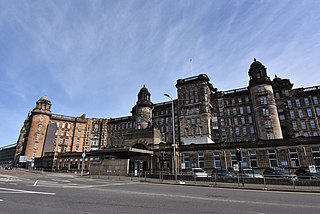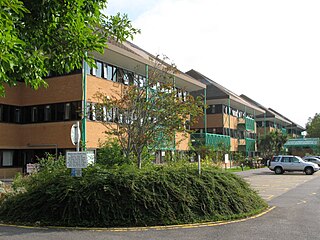
The Royal London Hospital is a large teaching hospital in Whitechapel in the London Borough of Tower Hamlets. It is part of Barts Health NHS Trust. It provides district general hospital services for the City of London and Tower Hamlets and specialist tertiary care services for patients from across London and elsewhere. The current hospital building has 845 beds and 34 wards. It opened in February 2012.
Holby is a fictional city in the United Kingdom, the setting for the BBC medical dramas Casualty and Holby City, and the police drama HolbyBlue. It is based on the real city of Bristol, where Casualty was formerly filmed, and is notionally located in the fictional county of Wyvern in South West England, not far from the border with Wales. While Casualty has been filmed in Cardiff since 2011, Holby City was filmed in Elstree, Hertfordshire. Both shows are set in the same fictional Holby City Hospital. Holby has an airport called Holby International.

Whipps Cross University Hospital is a large university hospital in the locality of Whipps Cross in Leytonstone and is within Epping Forest in the London Borough of Waltham Forest, London, England. It is managed by Barts Health NHS Trust.

The Alder Hey organs scandal involved the unauthorised removal, retention, and disposal of human tissue, including children’s organs, during the period 1981 to 1996. During this period organs were retained in more than 2,000 pots containing body parts from around 850 infants. These were later uncovered at Alder Hey Children's Hospital, Liverpool, during a public inquiry into the organ retention scandal.

The Glasgow Royal Infirmary (GRI) is a large teaching hospital. With a capacity of around 1,000 beds, the hospital campus covers an area of around 8 hectares, and straddles the Townhead and Dennistoun districts on the north-eastern fringe of the city centre of Glasgow, Scotland. It is managed by NHS Greater Glasgow and Clyde. It was originally opened in 1794, with the present main building dating from 1914.

Frenchay Hospital was a large hospital situated in Frenchay, South Gloucestershire, on the north east outskirts of Bristol, England, which is now closed. In 2014, it contracted to a few brain and head injuries services. It was managed by North Bristol NHS Trust.

Southmead Hospital is a large public National Health Service hospital, situated in the area of Southmead, though in Horfield ward, in the northern suburbs of Bristol, England. It is part of the North Bristol NHS Trust. The 800-bed Brunel Building opened in May 2014, to provide services, which transferred from Frenchay Hospital in advance of its closure. The hospital site covers 60 acres (24 ha).

Weston General Hospital is an NHS district general hospital in the town of Weston-super-Mare, Somerset, England, operated by University Hospitals Bristol and Weston NHS Foundation Trust. As of June 2019, the hospital had 261 beds and around 1,800 clinical and non-clinical staff. It has a part-time Accident & Emergency department, an intensive care unit, an oncology and haematology day unit, and a day case unit. The hospital also has a 12-bed private unit, The Waterside Suite, wholly owned by the hospital trust, with profits being re-invested into the main hospital.

The Royal Infirmary of Edinburgh (RIE), often known as the Edinburgh Royal Infirmary (ERI), was established in 1729 and is the oldest voluntary hospital in Scotland. The new buildings of 1879 were claimed to be the largest voluntary hospital in the United Kingdom, and later on, the Empire. The hospital moved to a new 900 bed site in 2003 in Little France. It is the site of clinical medicine teaching as well as a teaching hospital for the University of Edinburgh Medical School. In 1960, the first successful kidney transplant performed in the UK was at this hospital. In 1964, the world's first coronary care unit was established at the hospital. It is the only site for liver, pancreas and pancreatic islet cell transplantation and one of two sites for kidney transplantation in Scotland. In 2012, the Emergency Department had 113,000 patient attendances, the highest number in Scotland. It is managed by NHS Lothian.

The Royal United Hospital (RUH) is a major acute-care hospital in the Weston suburb of Bath, England, which lies approximately 1.5 miles (2.4 km) west of the city centre. The hospital has 565 beds and occupies a 52 acres (21 ha) site. It is the area's major accident and emergency hospital, with a helicopter landing point on the adjacent Lansdown Cricket Club field. The hospital is operated by the Royal United Hospitals Bath NHS Foundation Trust.

The Northern General Hospital is a large teaching hospital and Major Trauma Centre in Sheffield, England. Its departments include Accident and Emergency for adults, with children being treated at the Sheffield Children's Hospital on Western Bank. The hospital is managed by the Sheffield Teaching Hospitals NHS Foundation Trust.

Bristol Royal Hospital for Children, also known as the Bristol Children's Hospital, is a paediatric hospital in Bristol and the only paediatric major trauma centre in South West England. The hospital is part of the University Hospitals Bristol and Weston NHS Foundation Trust (UHBW), which includes eight other hospitals. The hospital is located next to the Bristol Royal Infirmary in the city centre.

Bristol General Hospital was a healthcare facility in Guinea Street, Harbourside, Bristol, in the south west of England. It opened in 1832, and closed in 2012. The BGH was managed by the University Hospitals Bristol NHS Foundation Trust. The building has since been converted into apartments.

The Hospital of St. Cross is a National Health Service hospital on Barby Road, in Rugby, Warwickshire, England, managed by the University Hospitals Coventry and Warwickshire NHS Trust. It is on the south edge of Rugby above a steep slope running down to the Sow Brook valley.
The Bristol heart scandal occurred in England during the 1990s. At the Bristol Royal Infirmary, babies died at high rates after cardiac surgery. An inquiry found "staff shortages, a lack of leadership, [a] ... unit ... 'simply not up to the task' ... 'an old boy's culture' among doctors, a lax approach to safety, secrecy about doctors' performance and a lack of monitoring by management". The scandal resulted in cardiac surgeons leading efforts to publish more data on the performance of doctors and hospitals.
North Bristol NHS Trust is a National Health Service trust that provides community healthcare and hospital services to Bristol, South Gloucestershire, and North Somerset, England. The trust employs over 8,000 staff and delivers healthcare through several medical institutions, including Southmead Hospital, Cossham Hospital, and the Bristol Centre for Enablement, as well as through various community-based clinics. In addition, medical teaching facilities are provided in association with the University of the West of England, Bristol University, and the University of Bath.
Healthcare in the city of Bristol, England and the surrounding area is largely provided by the National Health Service (NHS). Until July 2022, this was provided through the Bristol, North Somerset and South Gloucestershire clinical commissioning group. Facilities include a large teaching hospital – Bristol Royal Infirmary – which offers nationally commissioned specialist cardiac, cancer and children's services from its city-centre campus to patients in the southwest of England and beyond.

The University Hospitals Bristol and Weston NHS Foundation Trust (UHBW) is a National Health Service foundation trust in Bristol and Weston-super-Mare, England. The trust runs Bristol Royal Infirmary, Bristol Heart Institute, Bristol Royal Hospital for Children, Bristol Eye Hospital, South Bristol Community Hospital, Bristol Haematology and Oncology Centre, St Michael's Hospital, University of Bristol Dental Hospital and, since 1 April 2020, Weston General Hospital.

Bristol Eye Hospital is a specialist ophthalmic hospital in Bristol. It is part of the University Hospitals Bristol and Weston NHS Foundation Trust. The University of Bristol Dental Hospital is adjacent, and the Bristol Royal Infirmary is nearby.

Salford Royal Hospital is a large university teaching hospital in Pendleton, Salford, England operated by Northern Care Alliance NHS Foundation Trust. It was previously one of the top-performing hospitals in the United Kingdom.



















